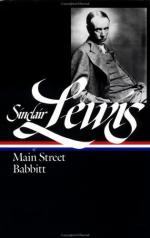|
This section contains 271 words (approx. 1 page at 400 words per page) |

|
Main Street Summary & Study Guide Description
Main Street Summary & Study Guide includes comprehensive information and analysis to help you understand the book. This study guide contains the following sections:
This detailed literature summary also contains Bibliography and a Free Quiz on Main Street by Sinclair Lewis.
Main Street, originally published in 1920, is the story of a sophisticated young woman who moves to a small town in the American Midwest in 1912 and struggles against the small-minded culture of the citizens who live there. The town, Gopher Prairie, is closely patterned on Sauk Centre, Min-nesota, which is where Sinclair Lewis grew up, although the book makes clear that it could be any of thousands of towns across the heartland. Carol Kennicott (née Milford), the protagonist of this novel, is a fascinating study in complexity: she loves her husband enough to live in Gopher Prairie with him, yet nearly enters several affairs in her longing for freedom; she hates the town for its gossip and its simplicity but wants nothing more than to make it better. The book touches on eternal American issues, such as women's rights, business among friends, and the spirit of anti-intellectualism that has always been at the center of small-town America, where sensitivity is often equated with self-absorption.
Main Street was an immediate, phenomenal success when it was published in 1920, making it the book of the century up to that point. It was the first in a string of novels written by Sinclair Lewis in the 1920s, including Babbitt, Arrowsmith, and Elmer Gantry, that established him as one of the preeminent authors of American literature. In these works, Lewis presents a response to a form of simplistic enthusiasm that tends to run through American culture, examining institutional religion, art, business, patriotism, and medicine with a skeptical eye. In 1930, he became the first American author to be awarded the Nobel Prize for literature.
Read more from the Study Guide
|
This section contains 271 words (approx. 1 page at 400 words per page) |

|



